Elizabethan Religious Settlement
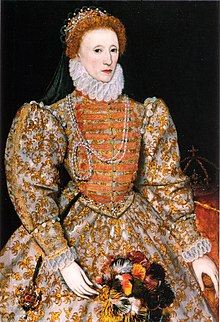
| Part of a series on the |
| History of the Church of England |
|---|
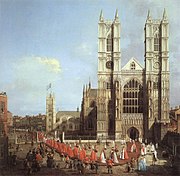 |
The Elizabethan Religious Settlement is the name given to the religious and political arrangements made for England during the reign of Elizabeth I (1558–1603). The settlement, implemented from 1559 to 1563, marked the end of the English Reformation. It permanently shaped the Church of England's doctrine and liturgy, laying the foundation for the unique identity of Anglicanism.
When Elizabeth inherited the throne, England was bitterly divided between
The Elizabethan Settlement was an attempt to end this religious turmoil. The
The settlement failed to end religious disputes. While most people conformed, a minority of
The
Background
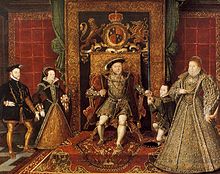
During Edward's reign, the Church of England preached
Mary I, Elizabeth's half-sister, became queen in 1553. She reversed the religious innovations introduced by her father and brother. Under Mary's rule, England returned to the Catholic Church and recognised the pope's authority. Mary died in November 1558 without a Catholic heir, leaving the throne to the Protestant Elizabeth.[11]
Elizabeth's accession
Elizabeth's religious views were Protestant, though "peculiarly conservative".
To avoid alarming foreign Catholic observers, Elizabeth initially maintained that nothing in religion had changed. A proclamation forbade any "breach, alteration, or change of any order or usage presently established within this our realm".[20] Nevertheless, Protestants were emboldened to practice illegal forms of worship, and a proclamation on 27 December prohibited all forms other than the Latin Mass and the English Litany.[15] It was obvious to most that these were temporary measures. Her government's goal was to resurrect the Edwardian reforms, reinstating the Royal Injunctions of 1547, the 1552 Book of Common Prayer, and the Forty-two Articles of Religion of 1553.[21]
Legislation
Reformation bill
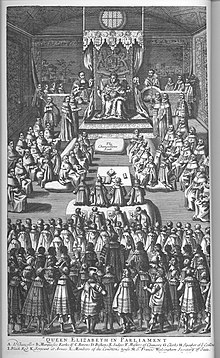
When the Queen's
The lay peers joined the bishops in their opposition and succeeded in amending the bill considerably. The ordinal and prayer book provisions were removed and the Mass left unchanged, with the exception of allowing communion under both kinds. The pope's authority was removed, but rather than granting the Queen the title of supreme head of the church, it merely said she could adopt it herself. This bill would have returned the Church to its position at the death of Henry VIII rather than to that when Edward VI died. It was a defeat for the Queen's legislative programme, so she withheld royal assent.[25][26]
Act of Supremacy
Following the Queen's failure to grant approval to the previous bill, Parliament reconvened in April 1559. At this point, the Privy Council introduced two new bills, one concerning royal supremacy and the other about a Protestant liturgy. The Council hoped that by separating them at least the Supremacy bill would pass.
The alternative title was less offensive to Catholic members of Parliament, but this was unlikely to have been the only reason for the alteration. It was also a concession to the Queen's Protestant supporters who objected to "supreme head" on theological grounds and who had concerns about a female leading the Church.
The bill included permission to receive communion in two kinds. It also repealed the medieval heresy laws that Mary I had revived. Catholics gained an important concession. Under the bill, only opinions contrary to Scripture, the General Councils of the early church, and any future Parliament could be treated as heresy by the Crown's ecclesiastical commissioners. While broad and ambiguous, this provision was meant to reassure Catholics that they would have some protection.[29]
The bill easily passed the House of Commons. In the House of Lords, all the bishops voted against it, but they were joined by only one lay peer. The Act of Supremacy became law.[27]
Act of Uniformity and prayer book

Another bill introduced to the same Parliament with the intent to return Protestant practices to legal dominance was the Uniformity bill, which sought to restore the 1552 prayer book as the official liturgy.[30] It encountered more opposition in the Lords than the Supremacy Act, passing by only three votes. Even this was possible only through political intrigue. Bishops Watson of Lincoln and White of Winchester were imprisoned in the Tower. Bishop Goldwell of St Asaph was never summoned to Parliament, and the elderly Bishop Tunstall of Durham was excused from attending on account of age.[31]
The Act of Uniformity required church attendance on Sundays and holy days and imposed fines for each day absent. It authorized the 1559 prayer book, which effectively restored the 1552 prayer book with some modifications.[32] The Litany in the 1552 book had denounced "the bishop of Rome, and all his detestable enormities".[30] The revised Book of Common Prayer removed this denunciation of the Pope. It also deleted the Black Rubric, which in the 1552 book explained that kneeling for communion did not imply Eucharistic adoration.[30]
The
The most significant revision was a change to the Communion Service that added the words for administering sacramental bread and wine from the 1549 prayer book to the words in the 1552 book.[36] When communicants received the bread, they would hear the words, "The body of our Lord Jesus Christ, which was given for thee, preserve thy body and soul unto everlasting life [1549]. Take and eat this in remembrance that Christ died for thee, and feed on him in thy heart by faith with thanksgiving" [1552].[37] This combination could be interpreted as an affirmation of an objective real presence to those who believed in it, while others could interpret it to mean memorialism.[38]
Scholarly interpretation
In his "
Another historian, Diarmaid MacCulloch, also finds Neale's thesis flawed.[13] At the same time, he calls the idea that the prayer book modifications were concessions to Catholics "absurd", writing that "these little verbal and visual adjustments" would never satisfy Catholic clergy and laity after the loss of "the Latin mass, monasteries, chantries, shrines, gilds and a compulsory celibate priesthood".[14] He argues the modifications were most likely meant to appease domestic and foreign Lutheran Protestants who opposed the memorialist view originating from reformed Zurich.[38] In 1559, Elizabeth was still unsure of the theological orientation of her Protestant subjects, and she did not want to offend the Lutheran rulers of northern Europe by veering too far into the Reformed camp. "It was worthwhile for Elizabeth's government to throw the Lutherans a few theological scraps, and the change also chimed with the Queen's personal inclination to Lutheran views on eucharistic presence."[14]
Historians
Implementation
Episcopal appointments
To enforce her religious policies, Queen Elizabeth needed bishops willing to cooperate. Seven bishops, including
Elizabeth chose Matthew Parker to replace Pole as Archbishop of Canterbury. Parker was a prominent scholar and had served as chaplain to Elizabeth's mother, Anne Boleyn. Also, like Elizabeth, Parker was a Nicodemite—someone who stayed in England during Mary's reign and outwardly conformed to Catholicism. Most of the other posts went to Marian exiles such as Edmund Grindal for London, Richard Cox for Ely, John Jewel for Salisbury, William Barlow for Chichester and John Scory for Hereford. Those exiles with ties to John Calvin's reformation in Geneva were notably excluded from consideration. The Queen never forgave John Knox for writing The First Blast of the Trumpet Against the Monstruous Regiment of Women, which denounced female monarchs, and the Reformation in Geneva was tainted by association.[44]
Royal injunctions

In the summer of 1559, the government conducted a royal
According to the injunctions, church images that were superstitiously abused were condemned as idolatry, but the commissioners mandated the destruction of all pictures and images.[40] Across the nation, parishes paid to have roods, images and altar tabernacles removed, which they had only recently paid to restore under Queen Mary. They would spend more money on buying Bibles and prayer books and replacing chalices with communion cups (a chalice was designed for the priest alone whereas a communion cup was larger and to be used by the whole congregation).[46]

The Injunctions offered clarity on the matter of vestments. Clergy were to wear the
In some instances, the injunctions contradicted the 1559 prayer book. While the prayer book directed the use of ordinary bread for communion, the Injunctions required traditional wafers to be used.
The Queen was disappointed by the extreme iconoclasm of the Protestants during the visitations. In October 1559, she ordered that a
Many parishes were slow to comply with the injunctions. Many did so out of sympathy with traditional Catholic religion, while others waited to see if this religious settlement was permanent before taking expensive action. Churchwarden accounts indicate that half of all parishes kept Catholic vestments and Mass equipment for at least a decade. Gradually, however, parishes complied as bishops exerted pressure. Most of the parish clergy were Catholics.[52] Through the mid-1560s, there were an estimated 800 clergy who resigned or were deprived for refusal to conform. Most parish clergy kept their posts, but it is not clear to what degree they conformed.[53] The bishops thought that Catholicism was widespread among the old clergy, but priests were rarely removed because of a clergy shortage that began with an influenza epidemic in 1558.[54]
Music
Devotional singing at home was shared between family and friends.[61] By far the most popular and reprinted metrical Psalter was Thomas Sternhold's Whole book of Psalms.[62] Although it was not legally required, it was traditional for virtually all Protestant churches and was also used at home.[63]
Thirty-nine Articles and the Homilies
The Elizabethan settlement was further consolidated by the adoption of a moderately Protestant doctrinal statement called the
With the Queen's approval, Convocation also issued a second
Reception
The settlement of 1559 had given Protestants control of the Church of England, but matters were different at the parish level, where Catholic priests and traditional laity held large majorities. The bishops struggled for decades to impose the prayer book and Injunctions on reluctant parishes. "For a while, it was possible to sustain an attenuated Catholicism within the parish framework, by counterfeiting the mass, teaching the seven sacraments, preserving images of saints, reciting the rosary, observing feasts, fasts, and customs".[67] Over time, however, this "survivalist Catholicism" was undermined by pressures to conform, giving way to an underground Catholicism completely separate from the Church of England.[67]
Gradually, England was transformed into a Protestant country as the prayer book shaped Elizabethan religious life. By the 1580s, conformist Protestants (termed "parish anglicans" by Christopher Haigh and "Prayer Book protestants" by Judith Maltby) were becoming a majority.[68][69][70] Efforts to introduce further religious reforms through Parliament or by means of Convocation were consistently blocked by the Queen. The Church of England's refusal to adopt the patterns of the Continental Reformed churches deepened conflict between Protestants who desired greater reforms and church authorities who prioritised conformity.[71]
Catholic resistance

In the early years of Elizabeth's reign, most Catholics hoped the Protestant ascendancy would be temporary, as it had been prior to Mary's restoration of papal authority. There were priests who conformed to the prayer book while also providing the Mass to their parishioners. Others refused to conform. Large numbers of
Catholics were forced to choose between attending Protestant services to comply with the law or refusing to attend. Those who refused to attend Church of England services were called
In 1569, the
By 1574, Catholic recusants had organised an underground Catholic Church, distinct from the Church of England. However, it had two major weaknesses: membership loss as church papists conformed fully to the Church of England, and a shortage of priests. The latter problem was addressed by establishing seminaries to train and ordain English priests. In addition to the English College at Douai, a seminary was established at
The Queen's excommunication and the arrival of the seminary priests brought a change in government policy toward recusants. Before 1574, most laymen were not made to take the Oath of Supremacy and the 12d fine for missing a service was poorly enforced.[82] Afterwards, efforts to identify recusants and force them to conform increased. In 1581, a new law made it treason to be absolved from schism and reconciled with Rome and the fine for recusancy was increased to £20 per month (50 times an artisan's wage). Afterwards, executions of Catholic priests became more common, and in 1585, it became treason for a Catholic priest to enter the country, as well as for anyone to aid or shelter him.[83]
The persecution of 1581–1592 changed the nature of Catholicism in England. The seminary priests were dependent on the gentry families of southern England. As the older generation of recusant priests died out, Catholicism collapsed among the lower classes in the north, west and in Wales. Without priests, these social classes drifted into the Church of England and Catholicism was forgotten. By Elizabeth's death, Catholicism had become "the faith of a small sect", largely confined to gentry households.[84]
Puritanism
| Part of a series on |
| Puritans |
|---|
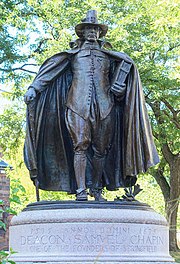 |
|
Leading Protestants within the Church of England were attracted to the Reformed churches of south Germany and Switzerland led by theologians such as John Calvin, Heinrich Bullinger and others.[85] In England, however, Protestants were forced to operate within a church structure unchanged since medieval times with the same threefold orders of bishop, priest and deacon along with church courts that continued to use medieval canon law. In addition, the liturgy remained "more elaborate and more reminiscent of older liturgical forms" and "took no account of developments in Protestant thinking after the early 1550s". According to historian Diarmaid MacCulloch, the conflicts over the Elizabethan Settlement stem from the "tension between Catholic structure and Protestant theology".[85]
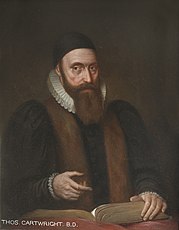 There were objections over the prayer book, including certain formulas and responses, the sign of the cross in baptism, the surplice and use of a wedding ring in marriage.[86] Throughout her reign, the Queen successfully blocked attempts by Parliament and the bishops to introduce further change. The bishops were placed in the difficult position of enforcing conformity while supporting reform. This was particularly evident between 1565 and 1567 during the Vestments controversy over the refusal of some clergy to wear the clerical dress required by the Royal Injunctions. For many Protestants, clerical vestments symbolised a continued belief in a priestly order separate from the congregation,[71] and could be interpreted by Catholics as affirmation of traditional doctrines.[87] Bishop Jewel called the surplice a "vestige of error".[86] In general, the bishops considered clerical dress adiaphora and tried to find compromise, but the Queen believed that the church—and herself as supreme governor—had authority to determine rites and ceremonies. In the end, Archbishop Parker issued a code of discipline for the clergy called the Advertisements, and the most popular and effective Protestant preachers were suspended for non-compliance.[88] The controversy over dress divided the Protestant community, and it was in these years that the term In 1572, a bill was introduced in the Queen's stranger church liturgies. Catholics, however, would have no such freedom. The Queen did not approve, disliking any attempt to undermine the concept of religious uniformity and her own religious settlement.[91]
By 1572, the debate between Puritans and conformists had entered a new phase—church government had replaced vestments as the major issue. 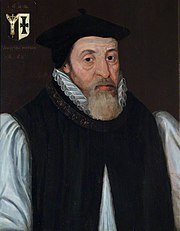 In 1577, Whitgift was made Bishop of Worcester and six years later Archbishop of Canterbury. His rise to power has been identified with a "conservative reaction" against Puritanism. It is more accurate to call Whitgift and those like him conformists, since the word conservative carries connotations of Catholicism.[97] The majority of conformists were part of the Reformed consensus that included the Puritans; what divided the parties were disputes over church government.[98] Whitgift's first move against the Puritans was a requirement that all clergy subscribe to three articles, the second of which stated that the Prayer Book and Ordinal contained "nothing ... contrary to the word of God".[99] Whitgift's demands produced widespread turmoil, and around 400 ministers were suspended for refusal to subscribe. Under pressure from the Privy Council, Whitgift was forced to accept conditional subscriptions from defiant ministers.[100] In the Parliaments of 1584 and 1586, the Puritans attempted to push through legislation that would institute a presbyterian form of government for the Church of England and replace the prayer book with the Hadrian Saravia began defending the English Church's episcopal polity more strongly, no longer merely accepting it as convenient but asserting it as divine law.[101]
In response to Bridges' A Defence of the Government Established in the Church of England for Ecclesiastical Matters, an anonymous Puritan under the pseudonym Martin Marprelate published a series of tracts attacking leading conformist clergy. The 1588 Marprelate Controversy led to the discovery of the presbyterian organisation that had been built up over the years. Its leaders were arrested and the Classical Movement disintegrated. This debacle occurred at the same time that Puritanism's most powerful defenders at Court were dying off. In the aftermath of the conformist assault, the 1590s were relatively free of theological controversy. Once Whitgift had destroyed presbyterian activism, he was content to leave the Puritans alone. Likewise, Elizabethan Puritans abandoned the hopeless cause of presbyterianism to focus on less controversial pursuits.[102] LegacyIn 1603, the King of Scotland inherited the English crown as James I. The Church of Scotland was even more strongly Reformed, having a presbyterian polity and John Knox's liturgy, the Book of Common Order. James was himself a moderate Calvinist, and the Puritans hoped the King would move the English Church in the Scottish direction.[103][104] James, however, did the opposite, forcing the Scottish Church to accept bishops and the Five Articles of Perth, all attempts to make it as similar as possible to the English Church.[105]  At the start of his reign, Puritans presented the Millenary Petition to the King. This petition for church reform was referred to the Hampton Court Conference of 1604, which agreed to produce a new prayer book, the 1604 Book of Common Prayer, that incorporated a few changes requested by the Puritans. The most important outcome of the Conference, however, was the decision to produce a new translation of the Bible, the 1611 King James Version. While a disappointment for Puritans, the provisions were aimed at satisfying moderate Puritans and isolating them from their more radical counterparts.[106] The Church of England's dominant theology was still Calvinism, but a group of theologians associated with Bishop Lancelot Andrewes disagreed with many aspects of the Reformed tradition, especially its teaching on predestination. Like the Puritans, Andrewes engaged in his own brand of nonconformity. In his private chapel, he added ceremonies and formulas not authorised in the prayer book, such as burning incense. James I tried to balance the Puritan forces within his church with followers of Andrewes, promoting many of them at the end of his reign. This group was led by Richard Neile of Durham and became known as the Durham House group. They looked to the Church Fathers rather than the Reformers and preferred using the more traditional 1549 prayer book.[107] Due to their belief in free will, this new faction is known as the Arminian party, but their high church orientation was more controversial.[108] During the reign of Charles I, the Arminians were ascendant and closely associated with William Laud, Archbishop of Canterbury (1633–1645). Laud and his followers believed the Reformation had gone too far and launched a "'Beauty of Holiness' counter-revolution, wishing to restore what they saw as lost majesty in worship and lost dignity for the sacerdotal priesthood."[108] Laudianism, however, was unpopular with both Puritans and Prayer Book Protestants, who viewed the high church innovations as undermining forms of worship they had grown attached to.[109] The English Civil War resulted in the overthrow of Charles I, and a Puritan dominated Parliament began to dismantle the Elizabethan Settlement. Episcopacy was replaced with a semi-presbyterian system. In 1645, the prayer book was made illegal and replaced by the Directory for Public Worship. The Directory was not a liturgical book but only a set of directions and outlines for services.[107] The  The Church of England was fundamentally changed. The "Jacobean consensus" was shattered, and the Church of England began defining itself less broadly.[113] The suppression and marginalisation of Prayer Book Protestants during the 1640s and 1650s had made the prayer book "an undisputed identifier of an emerging Anglican self-consciousness."[114] Historian Judith Maltby writes that Anglicanism as a recognisable tradition "owes more to the Restoration than the Reformation".[115] It was in the period after 1660 that Richard Hooker's thought became influential within the Church of England, as Anglicans tried to define themselves in ways distinct from Protestant dissenters.[115] Diarmaid MacCulloch states that Hooker's writings helped to create an "Anglican synthesis". From Hooker, Anglicanism "inherited its belief in the place of reason as an authority for action, its esteem for continuity over the Reformation divide, and a hospitality towards sacramental modes of thought". From the Arminians, it gained a theology of episcopacy and an appreciation for liturgy. From the Puritans and Calvinists, it "inherited a contradictory impulse to assert the supremacy of scripture and preaching".[116] The clash between Calvinists and Arminians was never resolved, and the "seesaw battle between Catholic and Protestant within a single Anglican ecclesiastical structure has been proceeding ever since".[117] The preface to the 1662 prayer book defined the Church of England as a via media "between the two extremes of too much stiffness in refusing and of too much easiness in admitting any variation".[118] Although Elizabeth I "cannot be credited with a prophetic latitudinarian policy which foresaw the rich diversity of Anglicanism", her preferences made it possible.[119] See also
ReferencesCitations
Bibliography
Further reading
External links |
